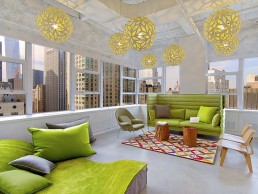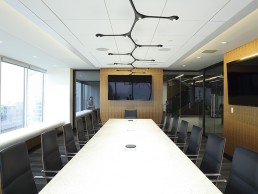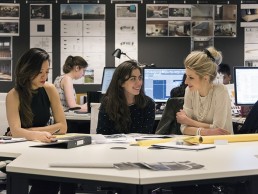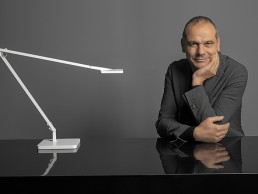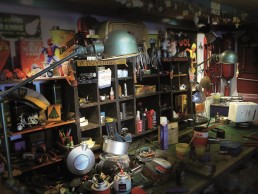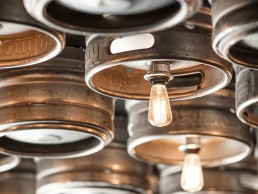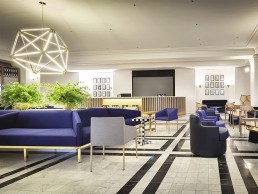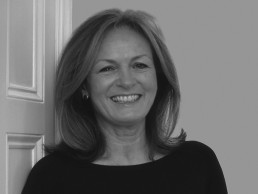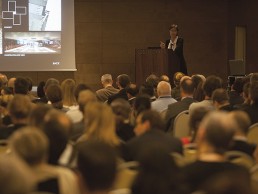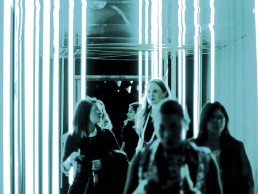Educators4Excellence, US
New York-based interior design studio Kati Curtis Design, tapped into educational non-profit firm Educators4Excellence’s refreshing and motivated professional approach, to create a stimulating working environment with the Big Apple at its core.
Rapidly growing educational non-profit organisation Educators4Excellence reached out to Kati Curtis Design (KCD) to create a new office space that would accommodate their national and local headquarters in New York City. Principle designer Kati Curtis met Educators4Excellence’s CEO at a tradeshow in New York, which marked the beginning of a synergistic design relationship that grew into the space they now occupy in downtown Manhattan.
As an advocate organisation for teachers, the client’s mission was serious – crystal clear, modern and clean. The CEO wanted a budget-friendly space that would be a sanctuary for working, training and supporting teachers not only in New York, but throughout the country. Clean lines, raw concrete floors, good lighting and ergonomic furniture were of paramount importance.
Located in New York’s Wall Street area, the decision was made to gut the space down to the raw structure. Keeping the original concrete floors and exposed ceilings opened up the space to city views, allowing in an abundance of natural light. With such a clean slate to work from, Curtis chose to exploit the organisation’s gestural apple logo as the key recurring element throughout the office.
“I envisioned millions of apples surrounding you as you enter the space,” said Curtis. The New York designer used the apples in different ways to define areas by printing them along glass partition perimeters, while still allowing light into the interior. The café and lounge areas feature David Trubridge’s Floral pendants with a yellow interior hanging above oak tables and tree stump coffee tables. These spaces double as work/meeting spaces where the lighting creates an energising link with the furniture.
The decorative pendants here work to reinstate the company’s logo shape and foundations of its modern, clean aesthetics. The project proved a success with staff as a playful yet productive space that evokes the organisation’s mission of advocacy and unification.
Avison Young, Canada
studio B architect's vision for commercial real estate firm Avison Young's Vancouver headquarters needed dynamic lighting to reflect the energy of its client.
studio B aimed to create a space that would connect people and reflect Avison Young's values, at its Vancouver headquarters.
Partner at Vancouver boutique design firm studio B architects, Michelle Fenton thought, “a well-tailored suit would be the right approach for the team at Avison Young; clean, well fitted and exquisitely detailed.”
Inspired by the beauty of the Pacific North West as well as emerging technologies, Studio B takes the approach that design not only encompasses the hard wall and edges of a room, but how it feels when it is in use, how one transitions from one room to the next, and what draws the user through the space.
Fenton sees lighting as a big part of that, as she tells darc: “Lighting is one of those subtleties in design that often gets forgotten, or is not integrated into the overall design. Clever use of lighting in concert with overall design can greatly enhance the experience of living in a space.”
A commercial real estate services firm, Avison Young’s headquarters includes a café and several small meeting rooms. Fenton comments: “Light can evoke a sense of place if selected appropriately. Throughout the project, our approach was to highlight the different types of areas with feature lighting. The goal was to create a different feel for each of the types of areas within the office. Given that the overall material design was fairly consistent, varying the quality and look of the lighting allowed us to vary the mood of the spaces. The café lighting was a bit more relaxed and playful while in the boardroom we opted for something more slick and badass.”
Studio B had a clear vision from the beginning of what the lighting in the boardroom should be like. “We were looking for something unique that spoke specifically to our client. This is why we chose Tokio’s Carbon Light in the boardroom – it’s evocative of a high end well-tuned racing bike; fast, efficient, cutting edge design and very, very slick.” Through the intelligent use of lighting, studio B succeeded in highlighting the client’s nature as a dynamic agency.
This energetic office project serves as an example of the power and versatility of decorative lighting to define a room’s personality. With dynamic lighting features, a working environment is brought to life to reflect the nature of its employees and the philosophy of the company.
Dara Huang
As an architect and founder of Design Haus Liberty in London, Dara Huang gives us her thoughts on how important the right working environment is and how feature lighting can play a crucial role.
Dara Huang is the founder of Design Haus Liberty (DHL), an international award winning architecture and interior practice based in London. Since 2013, the practice has been the recipient of The 2013 RIBA Forgotten Spaces Competition awards, showcased on the BBC and exhibited at The Somerset House, London; The Art Club Gallery, Seoul; while more more recently taking part in the Venice Biennale 2016.
With current projects including a 550 unit, new-build graduate housing block for The Collective; a 110 unit, new-build, mixed residential/commercial development in Central London; and £20m penthouses in South Bank Tower, Huang is well versed in restaurant, hospitality, commercial, residential and office design. Previous to setting up her own practice, she graduated from Harvard in 2007 and trained under the apprenticeship of Herzog de Meuron and Foster + Partners. There, she contributed to 56 Leonard Street and Tate Modern II Museum.
Her personal awards include The Clifford Wong Prize, The KPF Travelling Fellowship, The Young Architects Award, and First Place in The AIAS National Design Review. She was also personally invited to design the Samsung Pavilion for the London Olympics 2012.
While DHL is very much an architectural practice, with 25 architects currently ‘on the books’, for Huang it is a practice that is still very much led by design, telling darc: “I think because I come from an architectural background I can relate to this way of working much more, the way architects work with form, light and space. I like the way architects have a general way of wrapping their heads around things and then when we get into the details of a project, we turn to people from different disciplines to take it to the next level, such as product designers and lighting designers.
“Our strengths and our ‘bread and butter’ are our ideas,” she continues, “so first and foremost we’re definitely an architectural firm and then everything else comes out of that. When I started out on my own, I always did the architecture and the interiors but it was the interiors that caught the developer’s eye so we started doing more and more schemes, or we would be brought in as creative directors and end up consulting on all the other elements as well.”
For Huang and her team, whether the project is residential or commercial, it is important that they produce something unique to the client and use what is special about the area to influence the design. “We did a tech office where so many people were saying to us how much they loved the design and wanted us to recreate it… but we had to just say no! That’s not your office, that’s not the vibe you’re giving off and that’s not who you are, so let’s sit down and come up with something that’s right for you. Every site has character in its history and its context and needs looking at individually – from there, you bring out the roots of where the company’s from and what makes it unique.”
Commenting on office design specifically, for Huang the office sector is split into three types: the private owner; serviced offices which are growing in the market; and offices which are owned by a developer and rented out to multiple businesses. “There’s so many ways to design an office,” she tells darc, “but what I decided to do and what I think is the right direction, is to think about what a healthy office space means. So there definitely should be natural light adjacent to being able to see the outdoors and some aspect of greenery.
“There should also be a mixture of materials – not just all desks and hard spaces, introduce some soft seating, various lighting aspects. Mix it up from floor to floor – don’t just use carpets and tiles, but give the tenant something that says the space is more than just an office. At the end of the day, what you’re investing in is the amount of efficiency you will get out of each employee – meaning they will work better if they’re more comfortable, they’ll stay at the office longer if it feels more homely and also, you’re getting tenants that don’t want to leave which is a bonus for a landlord.”
The problem with the office space, according to Huang, is that a lot of the time, developers and landlords want the quickest, cheapest, solution and don’t often see the long-term cost of things. “Being cheap and cheerful can result in tenants moving out quicker,” she says, “meaning the landlords have then got to pay an agency to get people back in there. NeueHouse in New York is a great example of how it can work well. They created this amazing space, which has gone global and all eyes are on them. There’s a lot to be said for creating good space and I don’t care if it’s office type a, b or c. I think every one of those can have a touch of design.
“I think back in the 90s and early 2000s it was all about fire regulations, maximising your floor space and then copy and pasting the design all the way through the building,” Huang continues. “This is definitely being replaced with different ideas and you can see it in the new World Trade Center in New York where it used to be geared towards finance companies and now the new money makers are the tech guys. They’re not interested in uninteresting spaces, so they’ll add roof terraces to some of the floors and double height spaces so you can see the neighbours below, and cafes and so on…
“This connection with being more interesting in the design is something developers really need to think about and consider and if technology is the future, maybe we shouldn’t be copy and pasting things thinking that the next investment bank might take the space, but the next Google might take the space and want something more creative.
“Office space is evolving and I think that some of the industry is slow to pick up on this. I think honestly, it’s only going to improve by example; people are going to see things happening in New York, want it and copy it in about ten years time, it’s always the same. Technology and the internet aren’t going anywhere; our whole lives are controlled by apps so why should architecture stand still? It all needs to move together and office space needs to look to embrace creative needs, desires and spaces.”
For Huang, the right lighting within an office project is paramount to the entire environment. “It’s the most important thing,” she tells darc. “Not just for office designs, but in general, lighting sets your mood, how alert you are… everything! So when we’re doing a project we’ll look at lighting from a technical point of view, considering regulations, where switches should be and so on. Beyond that we’ll put in low heat emitting fluorescents that turn on by section, or whatever is needed.
“I feel it’s crucial to have key areas of lighting, especially feature lighting which is the one thing a lot of offices don’t have. So when we recently did a tech office we went out of our way to design things that purposely fit the identity of the office and introduced key light features. For example on one project we took spaghetti jars and turned them into a suspended chandelier, and we’ve used old recycled bottles and scripted them into an amazing sculpture that hangs over a reception desk space.
“These are definitely points of interest, so when I design an office I think of it as a collection of moments, which generally occur in a conference room, or over a reception desk, or maybe even in the main space. I think that people don’t use feature lighting enough, but that it is a really cool element that can impress visitors and make them stop for a second and think ‘wow’.”
Besides feature lighting, task lighting is another element Huang feels is important to incorporate into office design. Not only for efficiency reasons should an employee choose to work late into the night, but the fact it gives out a different colour light.
“So if you’re working on 2,700K then it will give you a much warmer glow,” she says. “Where as with building regulations and so on you need to implement fluorescent lights that produce that colder glow… And I don’t know about you, but when I sit under a cold light all day I just want to go to sleep! It’s not a good feeling. So, the more lights you can introduce and the more variety, changing the shade of the environment, the more you’re going to divert the attention of your task workers to work longer, more efficiently and so on…”
One such variation in lighting is the pendant, which for Huang can help create zones within an office – hung over a small meeting area or over the kitchenette. “Introduce a couple of gorgeous pendants instead of those stupid fluorescents again,” she says. “Lighting is THE most important thing. We’ll even use floor lights on some of our projects where it’s suitable. We did this for an industrial warehouse we were working on, we put them in the corners of the room and the light would shine up the edges of the exposed brickwork giving it a really dramatic effect – it changed the whole mood!”
With more and more companies using their office spaces 24hrs a day, for Huang it is imperative this is taken into consideration within the design, the space needs to be flexible to accommodate different scenarios and working needs and as part of this, varying lighting only works to aid the multitudes of work and nuances.
“The entire design of a space can be dictated by one light,” Huang tells darc. “We create bespoke light features as part of our service and in the past we’ve had clients with the most dire of spaces who have completely changed their mind once the lighting has been changed. It only takes one light piece to completely reform an entire space.”
Enzo Panzeri
Italian product designer Panzeri has firmly established itself as a leader in the lighting industry. With its history strongly rooted in family, it comes as no surprise that it’s lead designer is of the same name. darc met with Enzo Panzeri to discuss the importance of light and how design is moving further towards simplicity and elegance.
Since 1947, lighting brand Panzeri has been at the forefront of Italian design. Its core values of quality, research and innovation are firmly placed in its heritage in terms of tradition and craftsmanship and represent the brand philosophy.
Very much still a family run business, the company’s lead designer Enzo Panzeri considers himself an “autodidact, with a natural attitude for design.” With a passion for art and painting that raises an inner sensitivity towards beauty, this passion for visual art has inspired Enzo to turn on his creative flair.
Having grown up in Monza and Brianzo, a district of excellence in design and technique in Northern Italy, Enzo comes from an area with a great passion for hard work and dedication where technique mingles with Italian taste, resulting in a history of 500 years of research in beauty from the Renaissance onwards.
“This is a region where religion plays a strong role and the philosophy is to understand our past in order to improve the present and innovate the future,” Enzo tells darc. “Growing up in this environment gave me – and still does – the opportunity to develop my interests towards mechanical engineering and functional design, shaping myself into a figure able to combine my extreme sensibility towards visual art and technical drawings.”
But it is not only art that inspires Enzo; he recalls a trip to Brazil in the 1980s: “I am fond of beauty in all its forms and while in Brazil I remember being caught by the shape of a fisherman’s sailing boat. Its lightness and rounded form made me visualise the image of a product that I instantly had to draw in the sand. Soon after, I turned that idea into a tangible product.”
Going into the family business, for Enzo there was never another path he would have wanted to take: “I felt from my very first day that this was the place I was supposed to be. A world where it was possible to combine my creative attitudes with technique. Applying my natural tendency for design to the family business has been my only job.”
When it comes to designing a luminaire, for Enzo, it is important to always look at the industry and try to listen to the needs. “The essential difference between an artist and a designer is that the artist’s goal is to make a unique piece to showcase in a museum, while the designer’s goal is to make a serial product that can create a solution for as many people as possible.
“Light has the power to influence the mood, to transmit emotions, to change the look of a room. Light is the main influencer of our first view - just compare the light of a candle with the light of a dentist’s room.”
One of Enzo’s most notable designs, is also one of his most recent; the Jackie LED task light (pictured on the opening spread) has picked up design awards both in Europe and North America, but this – according to Enzo, is not the measure of it’s success. “I believe this product succeeded in combining a sense of elegance and beauty with technicality and a clean design. This is, for me, what makes a project notable since it conveys the philosophy of our territory.”
Jackie is a collection of LED multi-faceted lighting solutions ranging from a rigorous and functional desk lamp; an elegant and refined floor lamp; and an architectural object in its wall or ceiling spotlight version. Jackie strikes a balance between extreme linear simplicity and high architectural technical details. The revolutionary innovation of Jackie is indeed its structure, characterised by extendible arms and a double junction system, which allows the head to be orientated in multiple ways. A simple and minimalist design is obtained thanks to the miniaturisation of the elastic system, which is hidden in the body of the structure.
“My aim is to create a clean and simple style with mechanical perfection,” says Enzo. “The key is simplicity - employing mechanics to find the easiest solution for the desired design. I believe mechanics should be used to simplify products and procedures rather than making them intricate. This is why my design style is linear, clean and essential… It reflects my personality.”
As a company so well established in the lighting design industry, Panzeri has naturally played a role in the shift of lighting trends over the last few decades. “Lighting is becoming more and more minimalistic and embedded in architecture, mixed with the use of a few – but essential – decorative items,” says Enzo. “This is what I see also for the future of lighting. The predominant colours will be black and white mixed with the use of gold and other decorative colours. Though I have never developed an interest for different materials or colours, my attention is on the perimeter and shape of an object.”
Looking ahead, Enzo’s curiosity and perseverance will continue to see Panzeri lead in design. The designer is adamant he will continue reinventing and updating himself by continuing to look and listen to the lighting world. “This is the role of the designer,” he says, “to come up with a durable solution to the need. To me, design is working and responding to the needs of people, building a product able to interact with their daily routines. It’s a laboratory of daily work. Lighting to me – is functional and elegant simplicity.”
Deb Wythe
With eighteen years of lighting experience Deb Wythe started her award winning practice, Design In Progress, in 2010. Working on high end commercial and residential projects, she combines her product design skills with scheme designs and often integrates light into the fabric of the building, or creates bespoke lights for her projects.
Having played with light while studying for a degree in Furniture and Related Product Design at Ravensbourne College, she later went on to win an RSA award for a light she designed. Once graduated she completed private commissions before working for a couple of lighting manufacturers, and eventually moved to Lighting Design International, under the wing of Sally Storey, where she really learnt her trade, working her way up to Associate level. Wythe was also an Associate lecturer at Central St Martins on the BA Product Design degree course for five years whilst at LDI and last year, at the inaugural darc awards, her light art installation was voted second in the People’s Choice award.
“There seems to be a renewed interest in task lights. I wonder if this is because working from home is more prevalent or perhaps, because offices have become less sterile. Is this a trend or have designers picked up on research about the relationship between lighting conditions and productivity?
Surveys have concluded that poor lighting or eyestrain are frequent staff complaints. The major advantage of an adjustable-arm task light is that the user controls the lighting in their immediate work environment. This allows an individual to compensate for fluctuations with their visual acuity, as well as for variations in ambient lighting. But with current lighting control technology and the skills of lighting designers, it makes me wonder if we actually need desk based task lights at all. I think the answer is that it’s not about need but more about desire. We are, after all, talking about a light that performs several tasks. It has to provide even, glare free illumination to a workspace, local control of light levels, as well as be a beautiful piece of design on a desk. Lighting a desk can be done in many ways but when the light is something to see by as well as be seen, taste and trends play a big role in which fitting you choose or if you choose a dedicated task light at all.
Task lights have taken many forms over the years yet the functions have stayed the same – those being a light that provides a good output, low glare and an ability to move it freely into position enabling maximum control of the light level for optimal comfort.
Research suggests that if you were to just use a task light in a dark room, you would exhaust yourself more quickly. Your eyes would be constantly adjusting to the light and dark in the space causing eye strain and tiredness. It is important to have a general light in the room and on the walls so that when you look up from your task your eyes don’t have to keep adjusting to the light levels.
Advancements in materials and lighting technology have allowed for new forms and scales of task lights to be played with. These lights no longer need to be a round metal shade hiding a traditional filament lamp, thus opening up new opportunities for the form of the light fitting to take. Tizio, designed by Richard Saper in 1972 for Artemide, was one of the first desk lamps to use the low voltage halogen capsule lamp. A transformer in the lamp base, powers the halogen lamp through the moveable arms of the light’s form, eliminating the need for electric cables. It has a beautiful balance and form which is why Tizio has become a design classic and is still hugely popular.
Since high output LEDs have been made available, many designers have explored using a linear light source. A very elegant example of this is Vertigo Bird’s Antenna. When OLEDs were launched, Amanda Levete used them for the Established & Sons sculptural Edge task light. But for some reason it seems the current most popular task lights are two design classics that have been around for decades - The Angleposie, designed in England in the 1930s and the Jieldé ‘Standard’, a French design from the 1950’s. Both of these classics were instrumental in popularising the industrial look for domestic spaces and have been updated in recent years.
Sir Kenneth Grange redesigned the Anglepoise in 2003 and the brand has more recently collaborated with fashion designers Paul Smith and Margaret Howell who added more colourful palettes to the range. In doing these collaborations it has made the product more desirable to the domestic client, often using this light in living as well as working spaces.
When Jean-Louis Domecq developed the Standard in the 50s, creating the company Jieldé, he wanted something simple, robust and articulated in order to adapt itself to all workstations. The Standard also conducted the power through its arms and joints like Tizio but this wasn’t for aesthetic reasons. Electrical wiring was often a fire hazard back then in articulating lamps. Jieldé released the Loft lamp in 1987 and the Signal lamp in 2006, variations on the original that added colour and also made the lights a little smaller in scale in order to appeal to a more domestic consumer. Ironically, Anglepoise has gone in the opposite direction, and produced Giant versions of its lamps, including an IP rated one to be used outside.
With today’s technology a task light no longer needs to look like ‘a task light’ but people love the nostalgia of classics. If you indicate you are going to telephone someone you create a shape with your hands prescriptive of a phone designed in the 1930’s. Ask someone to sketch a task light and it’s likely to be something like the Anglepoise. The question is why do we do this when there have been so many different styles since its incarnation? So do we need table based task lights with today’s advanced lighting control systems? I don’t think so. Do we want a beautifully engineered design that provides local light on our desks? Yes!”
Das Bier, Canada
Das Bier in Montreal, Canada, is a place for beer lovers. Having taken over the premises of a former show bar, an industrial style German ‘bierhall’ concept has been implemented by Humà design + Architecture, featuring key design elements such as large round chandeliers, large communal tables, and lockers for the Bavarian beer mugs.
Humà’s first job was to open up the space, composed of three buildings with three different ground floor levels, to create one single large hall. During demolition a number of original materials were exposed and layers of the building’s history were revealed, which Humà was keen to make the most of. Features including terrazzo floors and a stone façade have been brought back to life with the warmth of wood walls and the sobriety of crude steel elements, enhanced by a contrasted black and white palette to heighten the mood.
Towering the space, large interpretations of the typical Bierhall chandeliers were introduced over communal tables. With the search for the perfect chandelier proving fruitless, the Humà team decided to custom design their interpretation of the Bierhall chandelier. Made from perforated hot rolled steel for its industrial feel, the chandeliers gently diffuse light through their perforated design.
“We had issues with their construction of course,” said Humà’s Mathieu Turgeon. “Initially, we asked for a diameter of 2.7m but the craftsman told us the largest diameter possible on his curving machine was 2.4m, so we had to make them a bit smaller. As it turns out we are quite happy with their size as they are a perfect fit for the space.”
Fixed to two large beams that now cross the open space, while the chandeliers aren’t totally centred over the communal tables, as guests enter, their attention is drawn to them, so placing them in the centre of the black beams gives a sense of symmetry to Das Bier. The language of the chandeliers continues throughout the space, including the exterior overhung façade and the internal steps that transition between the different levels inside the space - all made of crude steel.
“One of the client’s demands for the lighting was to be able to create different atmospheres with just one touch,” continued Turgeon. “The lighting had to be able to be dimmed during the night as well as be bright to announce closing time and help the cleaning team. As the space was initially composed of three distinct buildings covering 3,000sqft, this didn’t make it easy. All the electricity had to be redone so that we could work with a central dimming control panel pre-programmed to create different moods.”
Although there are a lot of windows at Das Bier, it is a bar that opens late in the afternoon so Humà had to work mainly with artificial lighting to create the right ambience. The design team did however use the windows in another way, enlarging them to create picture frames for people walking by to see the action inside. “The central large tables put people upfront in the space and that’s what you feel as you pass by,” said Turgeon.
Discussing the brief with darc, while initial plans didn’t change all that much over time, the client did ask Humà to incorporate new things into the project, mostly beer promoting elements. With access to free beer caps and aluminium beer kegs, they were incorporated into the design, as Turgeon explained: “We worked closely with the general contractor DVA entrepreneur généraux, to find ways of building the ideas we had on plans. We’ve designed the restroom’s entrance wall with a composition of 7,500 white and gold beer caps assembled into a pattern that reflects light and shines through the space. In addition, the ceiling in the VIP lounge is made of an assemblage of aluminium beer kegs cut in two on which we’ve added lighting fixtures, bringing down the ceiling for a more casual effect.”
With the chandelier and keg lighting fixtures firmly taking centre stage at Das Bier, Humà decided to complement them by gently lighting the walls with a curved rod black matte fixture. Working with the Boreal model from a local lamp design studio called Authentik Lighting, the copper interior of the fixture provides a warm lighting effect.
Reflecting on the project, for Turgeon one of the major success stories is the chandeliers, telling darc: “We are amazed by how close to our initial design the big chandeliers are. They are a key feature of the space and the fact they are custom handmade makes them even more impressive. The space within Das Bier is mainly wood panelling and a lot of black and white, so the lighting had to be really warm to create a cosy atmosphere.
“Deciding to custom design almost everything from the tables, the banquette, all the millwork, all the steel work across both bars and specifically the lighting fixtures made this project really different for us,” continued Turgeon. “We rarely design lighting fixtures so our main concern was to see if the effects we wanted would work – if the light would travel through the perforations we designed and mostly, if it would provide enough light on the tables where people would be eating, drinking and dancing.
“We didn’t have the budget or time to create a 1:1 scale model of the chandeliers so we had to make estimates and listen carefully to the advice given by the craftsman and general contractors we worked with. In the end I feel we accomplished something truly outstanding.”
Thanks to a flexible working relationship between all parties involved, the residents of Montreal now have a warm and inviting space to partake in their favourite German brew.
Selfridges International Tax Lounge, UK
The Selfridges International Tax Lounge in London brings luxurious surroundings to its customers through detailed design.
Providing an ambience similar to that of a business lounge at an airport, the new International Tax Lounge at Selfridges, London, is the first of its kind in the UK. London-based lighting design consultancy Illuminationworks collaborated closely with Waldo Works, architect and interior designer for the scheme, to create lighting that brings a hotel-style environment and service to the heart of one of London’s most iconic stores. Tripling in size from its previous tax service reception, the new areas within the International Tax Lounge provide comfort, luxury and relaxation enabling transactions to be undertaken privately and at leisure.
Illuminationworks’ Managing Director Chad Rains commented on the collaboration: “We’ve worked with Waldo Works on many projects over the years going back to 2001. We hadn’t worked with Selfridges since the Selfridges Hotel renovation project in 2008, which was put on permanent hold due to the financial crisis. The Waldo Works invitation to work on the lounge was a reintroduction to Selfridges that has continued to this day on several other retail projects.”
In the early 1900s when Selfridges opened, the era was marked by a golden age of travel and a growing opulence that influenced the way public and private buildings were designed. During this time, Selfridges opened its Palm Court restaurant, an eatery famously known for its vibrant, tropical décor.
“The lounge was inspired by that era, by a desire to bring back the Palm Court and golden age of travel with glass tunnels and palm trees,” said Rains.
From the very beginning, the project was about giving international customers, who form a very large part of total revenue for the brand, a lounge space within the department store. “The new space triples in size from the previous tax lounge, which resembled where your GP’s office meets the bus station,” commented Rains. With a range of facilities for overseas clients, the new 16,000sqft facility includes a main reception and waiting hall, as well as two banking halls, two libraries, a VIP area, café and quiet room. The scheme also includes a faith room, which is one of the first within a UK department store.
The central focus of the main waiting hall is Bec Brittan’s Shy pendant, which immediately draws attention to the lighting scheme that continues to stun throughout. Forming a key feature of the two spacious Banking Halls are bespoke globe light fittings manufactured by Nocturne in pendant, wall and table versions; these numbered glass globes hung from, or supported by, brass rails act as a vital element of the way-finding strategy. “Each globe is individually controlled to slowly flash when a customer’s number is called leading them to a particular tax desk,” explained Rains. “When you come into the reception area, you’re handed a ticket and you wait for it to appear on the screen. When it does, you follow the flashing light to that numbered desk. This non-verbal communication was crucial to the success of a space where transactions are carried out between individuals who rarely speak the same language.”
In a number of areas, including the VIP rooms and café, the architects have referenced a domestic setting with Vaughan’s Carcassone floor lamps and the Periscope Ball pendant by Areti selected to enhance a comfortable atmosphere. Within the faith room, Illuminationworks installed a sun-like circular fitting, Flos’ USO 900 Cove, set within a recess in the curved wall. This central feature of the faith room is surrounded by Chimera Controls' LED tape outlining the curve of the ceiling, which also feature elsewhere in the facility. The cooler light source of the sun, compared with the surrounding downlights, creates a calming focus to the room.
To control the ambience of each of these spaces, a dimming system was installed to alter the mood of the spaces throughout the day into the evening, balancing the artificial light with the increased levels of natural light, which was an important aspect of the brief. To achieve this, Lucent’s Prospex downlights used throughout the scheme feature LED dim to warm technology that mimics the dimming effect of halogen or incandescent sources, combining energy efficient technology with the mood-enhancing quality of traditional light sources. “This is the first project in which we’ve used the dim to warm technology and we’re excited about its potential as energy efficiency becomes ever more important.”
Despite being in a department store, Selfridges International Tax Lounge is essentially a hospitality project with soft, relaxing lighting that envelops the guest. “Downlights are carefully located over tables and in circulation areas but never over seating,” said Rains. Lighting is integrated only where possible and necessary, such as with new furniture pieces like the VIP Lounge banquette complemented by Vaughan’s Bolzano table lamps, and in the waiting hall where Azucena’s Imbuto Torchere free standing luminaires stand either side of a couch, offering a domestic illumination for the waiting space. “This less slick approach helps to reinforce the timeless quality the client was seeking,” said Rains.
With an expert focus on discretion within retail and hospitality sectors, Illuminationworks’ scheme within the Selfridges' tax lounge enables customers to have their tax-free paper work completed before going to the airport. “It is quite a specific function! We’ve never done anything like it. Light levels were very different from our hotel projects, and retailers are not used to the lower light levels of hospitality work. You can’t step directly from brightly lit linens into a moody lounge space. Where our instinct is to go dark and atmospheric, this space still had to fit with the character of the department store.”
Illuminationworks’ experience with retail, hospitality and high-end residential work was undoubtedly a benefit as this project brings together all three. Rains commented on the successful integration of the scheme: “It has been exciting to work on a project that is a first, and to hear that other stores are now looking at implementing similar areas is a compliment to the client as well as the entire design team. Our approach was to follow the aspirations of Waldo Works and to create a lighting scheme that helped provide the ‘cool luxury’ Selfridges wanted.”
Despite the challenge of ensuring that the demands of the area and its location tied together in a coherent way, the increasing popularity of these spaces being used for events and parties is a testament to its success. As a result, Illuminationworks is working on other projects for Selfridges in London, Manchester and Birmingham, and if the International Tax Lounge is anything to go by, they will be an enticing blend of domestic comfort in its highest form of luxury.
Diana Yakeley
A multi award-winning designer and past President of the British Institute of Interior Design, Diana Yakeley has been awarded an OBE in the Queen’s Birthday Honours List 2016, in recognition for services to the interior design profession. With a career spanning over 35 years, darc magazine caught up with Yakeley to find out the secret to her success.
AS A CHILD
My bus journey to school each day took me along the South Downs and I loved their light curves and mysterious valleys. I remember finding bee orchids and fireflies after dark and still today, get misty eyed when seeing the Downs on visits to friends.
Born in rural Hampshire, my parents gave me a part of the garden that was mine to do what I wanted with. This was the start of my love for gardening and feeling connected with nature. I also enjoyed digging deep tunnels and really hope the next owners didn’t fall into any of them!
THAT MOMENT
My mother told me I should learn to type before heading into a ‘den of iniquity’ (aka art school) as she called it. It was the early sixties... So I did learn to type and very useful it has been too, but I hung around Guildford Art School most of the time!
THE BIG SMOKE
Was definitely calling... I was desperate to leave home and set out for London without a plan, working in the photographic studio of the late fashion photographer John Cowan. This was the swinging sixties and an exciting and pivitol time in fashion and design. The studio was subsequently used to film Blow Up, loosely based on the life of David Bailey!
MARRIAGE
Came at a young age for me and I went on to have two wonderful children - both now photographers. It was then that I decided I really should do something creative to earn a living. There was a brilliant government scheme to encourage women to retrain and so I took myself off to the job centre and demanded to do interior design. After an initial look of surprise the man consulted his papers and said I could go to Dundee or Knightsbridge all expenses paid - Knightsbridge it was.
INSPIRATION
Comes from visits to Italy and France when looking at details and textures. I have always been influenced by architecture - forms, spaces, materials and the way light changes interiors. The Cistercian Abbey at Le Thoronet is perhaps the most perfect example of form and function, purity, harmony and that sense of place that lifts one’s spirit.
I like to work with a limited palette of colour and materials so that my clients’ personalities shine rather than any applied decoration.
THE OBE
Was an enormous and very emotional surprise! I am particularly proud that the citation is for services to ‘the UK Interior Design Profession’. Professional competence is at the core of what the British Institute of Interior Design stands for and has raised the awareness of high standards of practice over the years, so that word ‘profession’ means a lot to me.
THE PRACTICE
Was originally based in Cambridge and the work was entirely commercial. Stephen (my husband) designed a whole village in Saudi Arabia, several research establishments, as well as some award winning private homes.After the recession in the early 90s we moved to London and found that work in the residential sector was both enjoyable and creative - that’s where the majority of our work is now. We’re enjoying what we do and never want to stop!
LIGHT
Is the most important element in any interior and good lighting transforms ordinary spaces into interesting and well modulated environments to live or work. Technology changes so fast that such a specialist task is best done by specialists, we have worked most recently with Lighting Design International who have been inspirational in their approach to each project.
There is plenty of research into what makes poeple feel good at work and at home and lighting is key.
TRENDS
Are something I try to resist but I am so pleased that LED lighting is now so good and that it is possible to control lighting from an iPad anywhere in the world. I fear it may be too late for reinvention but I love sharing my experience with younger designers through mentoring and networking.
London Design Fair launches
(UK) - Ten years in the making, 2016 marks the launch of London Design Fair, the new umbrella brand that will include both Tent London & Super Brands London, alongside a growing host of international trade showcases.
As an exhibition, it has become adept at championing new designers, attracting global brands and showcasing country pavilions.
Thousands of new furniture, lighting, interiors products and ideas will be launched over the 4-day event, 22–25th September 2016. London Design Fair is the show for original thinkers and early adopters looking to discover the best in contemporary design.
Register now for your free trade pass or buy public tickets here.
www.londondesignfair.co.uk/visit
PLDC 2017 Call for Papers begins
(France) – Prospective contributors invited to submit papers dealing with recent findings, achievements or professional issues in field of light and lighting design.
As previously announced, effective 1 September 2016, the PLDC 2017 Call for Papers has begun.
This Call for Papers addresses both experienced practising professional lighting designers as well as the new generation of lighting professionals, plus dedicated researchers and educators, industry representatives and professionals from related disciplines whose work affects and involves professional lighting designers. PLDC is an educational event which encourages lighting professionals to share their insight and know-how, and where even the most skilled masters of the art can learn from newcomers.
The sixth Professional Lighting Design Convention will be held in Paris, France from 1-4 November 2017, following in the footsteps of the previous series of PLDC events to date: PLDC 2007 in London/UK, PLDC 2009 in Berlin/D, PLDC 2011 in Madrid/E, PLDC 2013 in Copenhagen/DK and PLDC 2015 in Rome/I.
The convention will address topics of concern and interest to lighting designers and lighting professionals worldwide, inviting them to expand their knowledge, exchange ideas and network on a platform that goes beyond national boundaries and regional associations’ work.
The Convention comprises a three-day conference with Keynote Speakers, presented papers, self-running poster presentations, a manufacturers’ exhibition, social and cultural evening events, organised moderated discussions, Experience Rooms, excursions, Round IV of The Challenge, and a Gala Dinner at which outstanding achievements in lighting design will be recognised. Pre-convention meetings prior to the conference will be dedicated to the further pursuit of the recognition of the profession and include sessions for educators and researchers, as well as discussion and debate on professional issues. A new-format Cities’ Forum will also be held, addressing lighting designers, city representatives, city planners, researchers and industry representatives.
The convention will officially open with a reception on 1 November and close with the Gala Dinner on 4 November, 2017.
The conference will comprise six Keynote Speakers, approximately 72 presented papers and around 20 electronic posters. All presentations will be held in English.
Prospective contributors are invited to submit papers dealing with recent findings, achievements or professional issues in the field of light and lighting design. The papers should be relevant to the following tracks:
Research (papers in fields such as Light and Health, Lighting Sustainability, Light and the Environment, Urban Development and Lighting, Light and Economic Issues, Light and Perception, Light and Psychology etc.). The papers will have a time frame of 20 minutes.
Lighting Application Case Studies (presentation of completed projects in interior and exterior lighting, demonstrating original approaches, uses of novel technologies, implementation of research findings, etc.). The papers will have a time frame of 45 minutes, including Q&A time.
Professional Practice Issues (status quo of the Architectural Lighting Design profession, Professional Deontology, Scope of Work, Best Practice examples, Cultural Context, Lighting Design Company and Human Resources Management, Lighting Education, Marketing, Risk Management, Business Administration, New Regulations and Guidelines, etc.). The papers will have a time frame of 45 minutes, including Q&A time.
Urban Life 4.0 (papers on light and light art in the urban realm, Lighting Festivals, Masterplans, spaces and sites, use of new technologies and Media Façades, interaction design, development of inner city spaces, working and living in different cities, project examples, social responsibility, security, etc.). The papers will have a time frame of 45 minutes, including Q&A time.
Research & Development (a dedicated track for the industry, the opportunity to present findings and research projects from the Industry’s point of view). The papers will have a time frame of 20 minutes.
Previously published/presented papers will not be accepted.
All papers are expected to be at a professional level and target a professional audience.
As an addition to the conference papers, the organisers will again offer Experience Rooms / Spaces. These rooms will invite and encourage attendees to actively experience light (and darkness) through different topics of interest to gain first-hand information, benefit educationally, and add to their personal and professional values and preferences when it comes to light and space. Proposed Experience Rooms will also need to go through the Call for Papers and be evaluated by the independent jury.
The Experience Rooms / Spaces will be opened on the three main conference days, from 8.30 to 18.30 on conference days.
All contributions are to be submitted in electronic format, along with the completion of the form on the PLDC website – www.pld-c.com – and follow instructions for uploading the requested material.
Abstracts should be submitted in English: 350 words minimum and 700 words maximum.
Prospective contributors should state their preference for the paper to be presented as a lecture or shown as a self-running poster presentation. The submissions will be blind-reviewed by the independent Paper Reviewing Committee who will evaluate the submissions and advise on the acceptance of a paper and whether a submitted paper should be presented orally or as a poster presentation. Decisions on the programme are not subject to legal appeal.
The deadline for all submissions is 18 November, 2016, 23.00 / 11 pm GMT.
Authors/speakers will be informed on the decision by VIA Events by 13 February, 2017.
For the preparation of the Proceedings for the event, and to support the preparation of the technical backup (computer network) selected authors/speakers will be required to forward their completepresentations in written format by 30 June, 2017 and in PowerPoint format by 31 July, 2017.
Information indicating required formats will be supplied in a Speaker’s / Poster Presenter’s Agreement. Authors of selected papers in all tracks will receive a free entry ticket to the convention (value € 675). This ticket does not include the gala dinner.
For the full Call for Papers and to submit a paper, click here www.pld-c.com
Ron Arad creates OLED light art for 100% Design
Ron Arad and design studio Zinoo Park collaborate with LG Display to bring to 100% Design an OLED light artwork.
Arad’s OLED installation will represent a perfect blend between this state-of-the-art lighting technology and artistry that can be applied to various spaces from high-end residential buildings to premium and luxury retail shops. At the same time, visitors will be able to witness the light qualities and physical characteristics that can only be expressed through OLEDs.
LG Display OLED light with Ron Arad at 100% Design marks a collaboration that sheds a new experience on light. Arad and Zinoo Park have embraced OLED Light panels as the medium to bring their next visions to life.
darc and mondo*arc to show darc night installations at Tent London
(UK) – darc and mondo*arc to launch darc awards / decorative alongside showcase of three 2.5sqm cube installations.
darc and mondo*arc magazines are teaming up to show three immersive light installations at Tent London that will first be shown at the darc awards / architectural event, darc night, on September 15th at MC Motors in London.
Tent London, under the umbrella of the London Design Fair, will take place in the Old Truman Brewery, located in the heart of East London, from September 22nd to 25th as part of the London Design Festival. Its 12,500sqm will showcase 250 independent designers and brands, 200 global brands and 15 country pavilions in ever-more creative formats.
To mark its tenth anniversary, and to accommodate continuing growth, the London Design Fair has grown to include an additional 3500sqm third floor. Over 25,000 influential retail buyers, architects, interior designers, press, designers, and design-savvy public (weekend only) attend annually.
The darc awards / architectural, organised by mondo*arc and darc magazines together with creative consultants Light Collective, is a celebration of the world’s best lighting design and is the world’s only peer-to-peer lighting design awards. darc night is a unique event to celebrate the winners of darc awards / architectural consisting of street food, a free bar and sixteen light installations by top lighting designers and manufacturers.
Paul James, editor in chief of darc and mondo*arc magazines and director of the darc awards, commented: “When we were approached by the organisers of London Design Fair to show some of the light installations that will be on display at darc night, the darc awards / architectural ceremony, it was an opportunity too good to miss. It will be great to showcase the creative talent of lighting designers involved in darc night to a wider audience, something we are strong advocates of at mondo*arc and darc.”
“We will also use the occasion to launch the darc awards / decorative concept which will have its own event in London in May 2017,” he added.
The darc night installations will be 2.5sqm cubes where the visitor will be able to walk into the space to experience and interact with the light.
The cubes will be designed by top lighting design practices in collaboration with high-end lighting manufacturers – Arup with Cooledge, Lighting Design International with KKDC and MS CHO Studio with Applelec.
The cubes will be housed within a molo softwall modular system – an innovative flexible wall designed by Stephanie Forsythe + Todd MacAllen that is part of MoMA’s permanent collection in New York.
THE DESIGNERS
Lighting at Arup brings together art, science and technology. Its global team of designers create expressive, sustainable and award-winning concepts in light. It understands the interplay of structural form and lighting, and work with architects and artists to provide original conceptual designs. Its technical knowledge ensures that concepts become viable solutions.
www.arup.com/services/lighting_design
Lighting Design International has been creating Adventures in Light for 30 years. Its work covers the architectural spectrum, including hospitality, super yachts, retail, office environments, heritage buildings, residential developments, luxury private homes and corporate headquarters worldwide – multi-award winning projects that represent the ultimate in high-end lighting design. Its portfolio boasts projects of every scope and scale, from boutique chic to classic opulence.
www.lightingdesigninternational.com
Min Sang Cho, director at MS CHO Studio, is a London based lighting artist who has a strong background in craft, design and architectural lighting engineering. After graduating from Royal College of Art in 2004, he has been actively working on large and small-scale projects for various clients, from a corporate to a charity. Min sang Cho distinguishes himself from other lighting engineers and luminaire creators by taking an innovative and versatile architectural approach.
www.mschostudio.com
THE MANUFACTURERS
Cooledge is changing the way light is materialized and integrated in architectural design, offering creatives the ability to transform the environments they design in new and unexpected ways. Its evolving portfolio includes both TILE and LINE solutions that allow architects and designers to re-imagine how and where they use light. Cooledge is widely used for luminous surfaces and very low profile installations in retail, office, entertainment, and hospitality environments around the world.
www.cooledgelighting.com
KKDC is an established manufacturer, designing and producing a wide range of specialist LED lighting solutions for high-end architectural markets worldwide. Research and manufacture take place in its expanding Korean facility outside Seoul, with product design and technical marketing services from KKDC Design House in London. From the start, the success of KKDC has always been grounded in our research and implementation of complete electronic and engineering solutions in the application of LED’s produced from the best performing patented materials.
www.kkdc.lighting
Established in 1998, Applelec is a northern manufacturing company renowned for the creation of bespoke lighting products including the award winning flat light panel, LED Light Sheet. Alongside in-house manufacturing, Applelec source and adapt innovative products to deliver imaginative project solutions. With two factories, a warehouse and a head office in West Yorkshire and a newly opened showroom at the Business Design Centre in London, Applelec is constantly evolving and expanding.
www.ledlightsheet.co.uk
Dedicated to an exploration of sensory experience in space making, combined with experiments in manufacturing, materials and structure, the molo studio explores overlapping realms of art, architecture and design. molo has created projects as diverse as a museum in Japan, a modular wall system and a tea set. molo's products are inspired by studies in architecture and the idea that smaller tactile objects have a real potency in the physical experience of the built environment.
www.molostore.com

